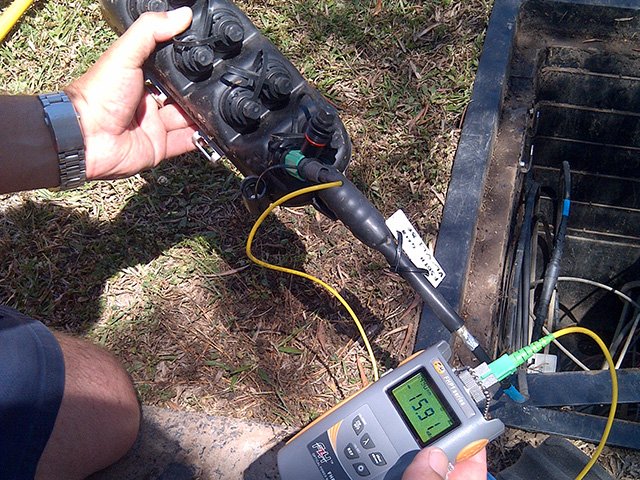Checking Out the Advantages of Optical Fiber Checking for Improved Communication Solutions
The value of optical fiber testing in contemporary interaction systems can not be overstated, as it works as a foundation for guaranteeing network integrity and efficiency. Utilizing innovative approaches such as Optical Time-Domain Reflectometry (OTDR) and insertion loss evaluation, organizations can not just determine mistakes however also enhance their configurations. This aggressive testing strategy has profound effects for signal quality and functional efficiency, raising the inquiry of how these methods contribute to long-lasting sustainability in an ever-evolving technical landscape. Comprehending these characteristics is necessary for stakeholders aiming to preserve an affordable edge.
Significance of Optical Fibre Screening
The relevance of optical fibre testing can not be overstated in today's data-driven atmosphere. As companies increasingly rely upon high-speed data transmission for daily procedures, the honesty and performance of optical fibre networks are critical. Checking ensures that these networks can sustain the huge quantities of information created and sent seamlessly, fostering efficient communication and connectivity.
Optical fibre testing serves multiple essential functions, including verifying installation quality, identifying potential faults, and determining overall system performance. Regular screening can protect against costly downtimes and solution disruptions, allowing organizations to keep functional connection. It aids in conformity with market standards and regulations, ensuring that fiber optic setups fulfill called for specs for safety and reliability.
In addition, testing can enhance the long life of fibre optic systems. By proactively identifying concerns such as signal loss, attenuation, or connector failings, organizations can attend to troubles before they intensify, therefore extending the life of their facilities. In recap, optical fibre screening is not simply a technological requirement but a calculated investment that boosts network dependability, optimizes efficiency, and ultimately sustains the growth and performance of contemporary interaction systems.
Key Examining Approaches

OTDR is a crucial strategy used to determine mistakes, measure splice losses, and examine the total integrity of a fibre optic web link. By sending out a pulse of light down the fiber and analyzing the shown light, professionals can pinpoint places of mistakes and examine the network's efficiency over long distances.
Insertion loss testing determines the quantity of signal loss that takes place when light passes through a connection or splice. This technique is vital for validating that links meet specified loss thresholds, which is important for preserving ideal efficiency in interaction systems.
Optical return loss screening evaluates the quantity of light mirrored back in the direction of the resource as a result of blemishes in the fiber or links. High return loss worths show better efficiency and reduced signal degradation.
With each other, these testing methods provide an extensive analysis of fibre optic networks, guaranteeing their integrity and functionality in varied interaction applications.
Effect On System Efficiency
Efficient optical fibre testing directly influences the overall efficiency of interaction systems. By making sure the stability of fibre optic cables, screening recognizes possible faults such as attenuation, splice loss, and connector imbalance. These concerns can substantially break down signal high quality, causing disruptions and decreased information transmission rates.

In addition, regular optical fiber testing adds to long-term system sustainability. It allows very early detection of damage, enabling prompt maintenance and upgrades before significant failures happen. This not only prolongs the life-span of the infrastructure however additionally guarantees that interaction systems remain affordable in regards to performance.
Cost-Effectiveness and Effectiveness
Cost-effectiveness is a crucial consideration in the release and upkeep of optical fibre networks. Carrying out durable optical fiber testing treatments can dramatically decrease functional prices by identifying issues before they rise right into major problems. robotic vision. By finding mistakes, depletion, and other efficiency barriers early, organizations can avoid expensive repair services and downtime, which can interfere with solutions and bring about income loss
In addition, effective testing methodologies simplify the installment process, permitting service technicians to work better. This equates to lower work expenses and faster project conclusion times. Advanced testing tools, such as Optical Time Domain Reflectometers (OTDRs), enables a specific evaluation of fibre top quality, making sure that only optimum materials are used, consequently reducing waste.
Normal testing additionally contributes to far better resource allocation. By comprehending the network's performance, organizations can make enlightened decisions concerning upgrades and growths, ensuring that investments are made where they are most required. In summary, optical fiber screening boosts cost-effectiveness and performance, supporting the long-term sustainability and competition of interaction systems in an increasingly requiring market.
Guaranteeing Long-Term Integrity
Executing strenuous optical fiber testing not just enhances price financial savings and functional efficiency but additionally plays an essential duty in making sure the visite site lasting reliability of interaction networks. Consistent screening methods, consisting of attenuation and data transfer analyses, aid identify prospective deterioration in fiber efficiency before it results in solution interruptions.
By utilizing sophisticated screening techniques, network drivers can pinpoint try these out faults or weaknesses in the fibre facilities, enabling prompt removal. This aggressive strategy minimizes downtime, ensuring that communication systems remain useful and efficient. Furthermore, regular testing contributes to the development of a more resilient network, as operators can adjust and maximize their framework based upon real-time information understandings. optical fibre testing equipment.
Additionally, ensuring compliance with sector criteria with optical fibre testing enhances the top quality and stability of the entire communication system. This adherence not just strengthens self-confidence among stakeholders but additionally lines up with regulative requirements, which are significantly rigid.
Final Thought
In final thought, optical fibre screening functions as a fundamental part in improving communication systems. By employing various screening methods, such as OTDR and insertion loss assessments, networks can accomplish optimal efficiency and dependability. The proactive recognition of faults not just enhances signal top quality however also lowers downtime, eventually adding to cost-effectiveness and functional efficiency. Adherence to market criteria fosters stakeholder self-confidence, ensuring the long-lasting sustainability of communication facilities in a significantly data-driven landscape.